Resonance in watchmaking is a rare thing to behold, with only a handful of watchmakers today incorporating it into their work, which gives an idea of just how technically complex it is. For this instalment of “It’s Complicated”, I’ll take a look at what resonance actually is, how it works, and resonance in watchmaking – both historically and today. I even got to catch up with Claude Greisler, Co-Founder of independent manufacturer Armin-Strom!
What is resonance?
To start with, let’s look at what exactly the phenomenon of resonance is. In scientific language, resonance describes the tendency of anything to vibrate or oscillate at a naturally occurring frequency, as well as how the amplitude (or strength) of an object’s natural occurring frequency can be increased when another object of the same natural frequency acts upon it.
Make sense? No? You’re not alone! It is far from the simplest of concepts, however there are real-world applications of resonance which can help to explain; firstly, imagine pushing a child on a swing. As they swing back and forth, we instinctively use the concept of resonance to keep them swinging and to push them higher – when they reach the peak of their backswing, we apply a pushing force which matches the swinging motion. Applying this force at this exact moment results in a stronger swing motion, with the swing going higher.
Another example is a well-known experiment using two tuning forks on a table. If you give strike one of the forks and apply its base to the table to generate a musical note, if you also place it next to a second tuning fork, it too will start vibrating and create the same sound, despite it not having been struck:
Resonance tuning fork experiment (sound on)
The history of resonance in watchmaking
Strictly speaking, all mechanical timepieces, whether a pendulum clock or an automatic watch with a balance wheel, can be described as ‘resonant’ – each has a natural frequency at which they swing or oscillate, which is used to keep time. However, what stands a resonance timepiece apart is a complexity to harness timekeeping benefits by introducing a complication that exhibits the resonance phenomenon described above.
Christiaan Huygens, the inventor of the pendulum clock, first noticed in his workshop in 1655 that if he had multiple pendulum clocks suspended from the same wooden beam, over time the swing of these pendulums would synchronise. If he disrupted this and set them independently, he noticed they would again automatically sync up once more. This marks the first instance of resonance in horology.
The next notable contribution to the evolution of resonance in horology was through Antide Janvier, a French clockmaker who was famous for creating “double pendulum” or “resonance” clocks, incorporating two entirely separate movements with their own escapements and pendulums into the same clock, with the pendulums placed close together. His original hypothesis when starting out with this work proved correct: resonance meant the pendulums would ultimately synchronise and oscillate back and forth at same frequency, resulting in an overall improvement in accuracy as any variances in the frequency of either pendulum’s swing is averaged out by the other.

Christiaan Huygens (1629-1695)
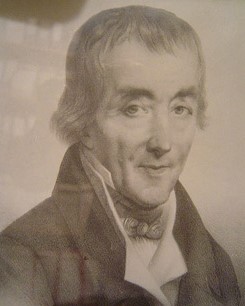
Antide Janvier (1751-1835)
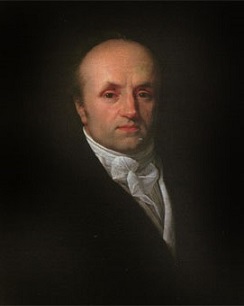
Abraham-Louis Breguet (1747-1823)
Resonance was also something that arguably one of the most influential watchmakers in history, Abraham-Louis Breguet, dabbled in too. Continuing Antide’s work, Breguet’s famous double pendulum clock from the early 1800s used resonance to keep the pendulums at the exact opposite phase of their swing, with any variance in one swing subsequently cancelled out by the other thanks to the resonance phenomenon again serving to keep a greater degree of accuracy in the clock.
Breguet also became the first person to incorporate two balances into a single pocket watch, placing them so closely together that they would harness the benefits of resonance. There are only a handful of such examples in the world, one of which was auctioned in 2012 and ultimately sold back then for a whopping CHF 4,339,000 or almost £3.6m.
Following Breguet, resonance in horology remained essentially dormant for not far off two centuries, until Breguet’s work served to inspire a modern-day genius in the form of François-Paul Journe.
Resonance in modern day watchmaking
Even with the advances in science and technology that we have today, resonance is still something which is exceedingly rare in watchmaking mastered by only a few.
Within a wristwatch, as with Breguet’s pocket watches, the resonance phenomenon is introduced by incorporating two completely independent movements – mainsprings, geartrains, balance wheels and escapements – within the same timepiece, where the balance wheels are placed close enough together that they come under the spell of resonance and oscillate in unison.
The advantages are the same, too, in that two balance wheels oscillating in resonance keeps a greater level of accuracy over the course of a day, as any discrepancy in oscillating frequency of one balance wheel is counteracted by the other.
Let’s take a look at some contemporary examples.
F.P Journe Chronomètre à Résonance
In 1983, inspired by the work of Abraham-Louis Breguet, a young François-Paul Journe sought to pick up the horological mantle of resonance once again, looking to both harness the accuracy benefits afforded and simultaneously pay tribute to watchmakers such as Huygens, Janvier and Breguet who had inspired him so. Journe was just 26 years old.
It took Journe a further 15 years of research to adapt resonance into a wristwatch for the very first time, and in the year 2000 his dream was realised with the release of the Chronomètre à Résonance. To implement this in a wristwatch, Journe developed the calibre 1499 movement with two barrels, separately driving two independent gear trains and balance wheels; the balance wheels are placed close together, physically connected by a mainplate. For the first 4 years of production, the movement was made in brass before eventually switching to rose gold from 2004 onwards. The photographs below show the two time displays drive by two independent movements, and the movement in rose gold – notice the proximity of the two balance wheels and the plate connecting them:
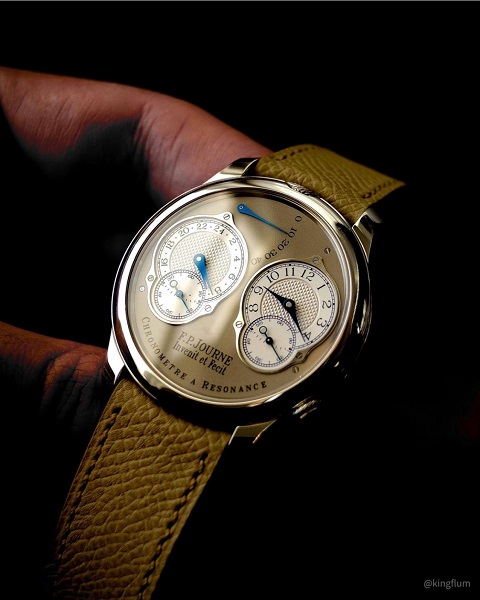
F.P. Journe Chronomètre à Résonance, photos courtesy – @kingflum ©
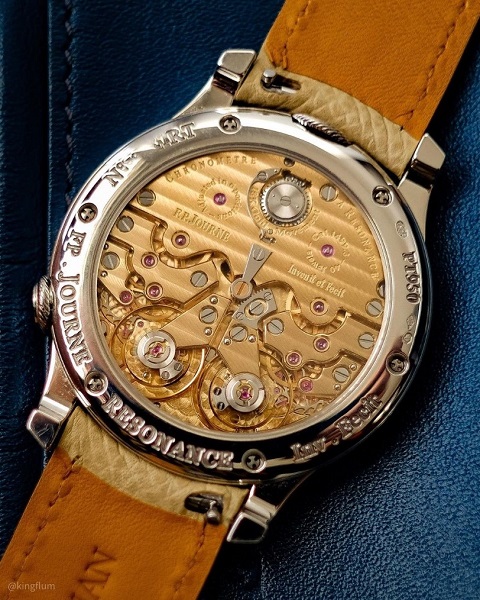
More recently, to mark the 20th anniversary of the 2000 release of the Chronomètre à Résonance, Journe has added considerably to the complexity of the piece with the new calibre 1520, which introduces a single barrel which drives two independent gear trains and balance wheels, thanks to a newly added differential.
I think it is fair to say that Huygens, Janvier and Breguet would be suitably impressed…
A special thanks to @kingflum for use of his photographs.
Armin Strom Resonance Watches
Independent manufacturer Armin Strom have created different varieties of resonance timepieces since the brand was founded in 2006. I was lucky enough to speak with Co-Founder Claude Greisler about resonance, and how he was inspired to incorporate it into the work that Armin Strom do:
“I was already interested in the phenomenon of Resonance during my studies in watch restoration. I did a lot of research during that time and thought it would be the perfect project after we build up the manufacture Armin Strom together with my business partner Serge Michel. The goal of every watchmaker is to make the watch more precise and Resonance can definitely help here.”
The differentiator with Armin Strom is their patented clutch spring, which took three years to develop, test and optimise – all completed in house. The clutch spring serves both to provide a physical connection between two separately driven balance wheels and also a vehicle through which we can see resonance – the clutch spring pulses back and forth as the balance wheels oscillate in anti-phase resonance of one another. The clutch spring helps eliminate variances in the frequency of balance wheel oscillations by almost ‘pulling’ the balance wheels along together, ensuring they remain in sync.
“The idea [of the clutch spring] is inspired by the studies of Christaan Huygens and the Double Pendulum clock of Antide Janvier. They have both discovered that the two regulators have to transmit their vibrations. Huygens had the table transmitting the vibrations and Janvier shared the suspension of the pendulums. Their studies inspired us to develop a suspension for hairsprings, our clutch spring.”
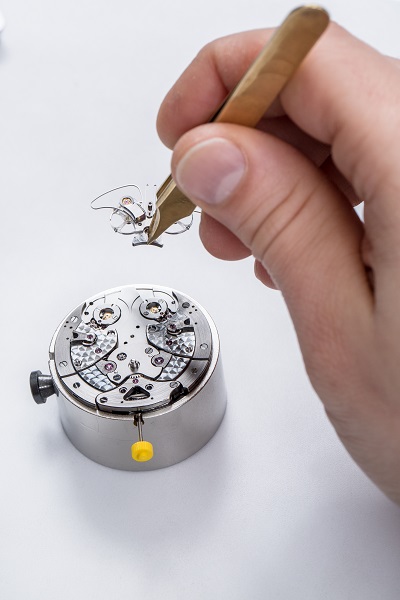
The clutch spring being applied to a movement, photo courtesy – Armin Strom ©
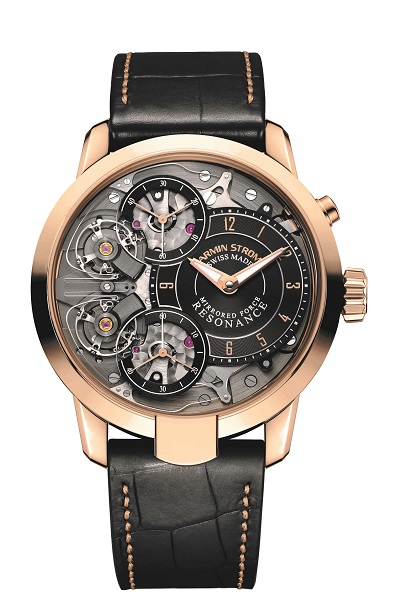
Armin Strom Mirrored Force Resonance, photo courtesy – Armin Strom ©
With the Mirrored Force Resonance, the movement introduces two seconds indicators, one for each balance wheel, to visibly demonstrate the synchronicity induced by resonance. Further adding to the complexity, these can instantly both be set to zero by actuating the pusher at 2 o’clock.
“The zero-set mechanism is necessary to have a visual proof of resonance. The fact that you can zero-set them allows the owner to see if their watch is perfectly in resonance. We wanted to make Resonance visible for the collector. That’s why on the Mirrored Force Resonance you can see the Resonance Clutch Spring but also the two second indications. Once your watch is in Resonance, after around 5 min if you wind the watch for the first time, you can press the pusher and synchronize the two second indication to have the visible proof. It also shows that you have two completely independent calibres in one watch. The upper second is turning counter clockwise and the lower second clockwise.
“The Development of the whole timepiece took my team around 3 years. Thanks to the support we got from the CSEM (University of Neuchatel) we were able to develop the clutch spring in a very short time. Their experience in flexible suspension was very helpful for us.”
Armin Strom have produced the world’s only chiming resonance watch in their minute repeater resonance, of which they produced only 10 to mark their tenth anniversary, as well as a dual-time resonance watch with a sapphire case which is limited to only 8 pieces. The dual time introduces a double barrel to each of its two independent movements, each displaying a separate time zone on its own dial. In total, this piece has 4 individual barrels, each of which are wound when turning the crown.
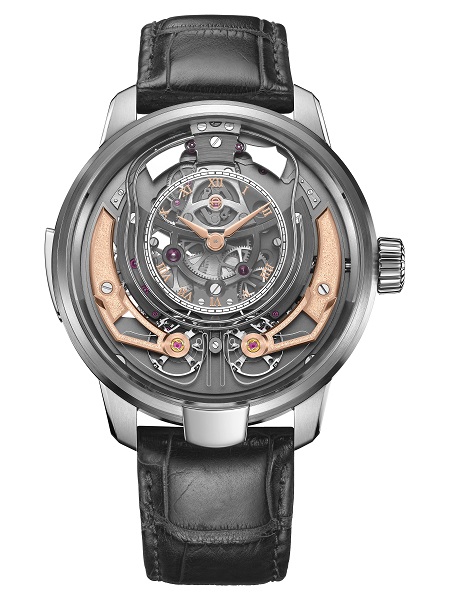
Minute Repeater Resonance, photo courtesy – Armin Strom ©
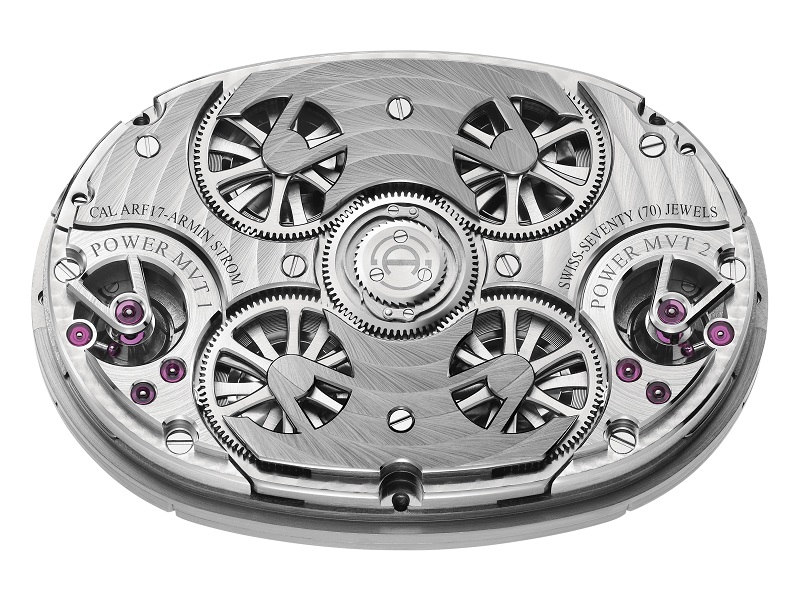
Resonance Dual Time movement, photo courtesy – Armin Strom ©
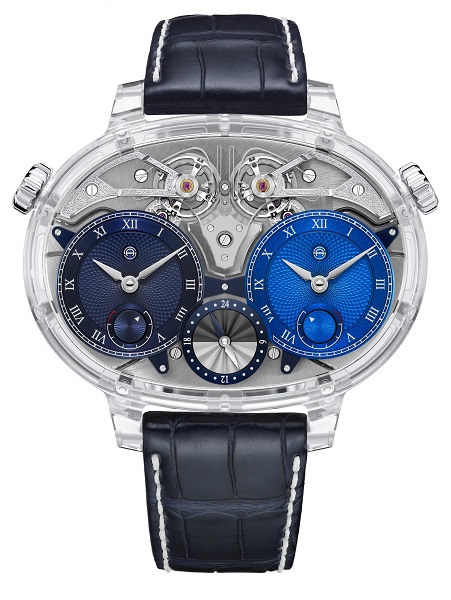
Resonance Dual Time Sapphire, photo courtesy – Armin Strom ©
“With the masterpieces we want to show what we are able to develop and produce in our manufacture. Having two completely independent watch movements within one timepiece created for us the logical demand of showing two time zones. The Minute Repeater Resonance is the first repeater in the world using the phenomenon of Resonance. We wanted to create a very special and historical timepiece for the 10th anniversary of our manufacture back in 2019. That’s also why the Minute Repeater Resonance is limited to only 10 timepieces and as you can imagine, only a few numbers left!”
Resonance is not the only innovation in the Armin Strom tool kit – the Gravity Equal Force introduces a special mechanism to the barrel to ensure that it delivers a constant force to the balance, ensuring precision timekeeping even when the power reserve on a watch is low. In a relatively short space of time, this independent manufacture has achieved an awful lot and I think is certainly one to keep an eye on in the future.
“It makes me very happy to see from where we are coming and where we are today. Imagine, we had to learn how to produce a screw and today we are manufacturing timepieces like the Minute Repeater Resonance. It makes me proud to be able to do what I love together with my team which is watchmaking. And furthermore, with what we have learned in the past, we can today create new innovations for the whole industry. Think at the Gravity Equal Force and the ingenious Stop-Work barrel.”
Haldimann H2 Flying Resonance
A completely different approach to resonance was taken by independent watchmaker Beat Haldimann. Haldimann had been occupied with the idea of resonance since 1981 when writing a school assignment. He first started looking at it with respect to horology in 1998 when developing the H101 Resonance Classic, a clock with two precision pendulum movements, which despite not being physically connected will synchronise through resonance into anti-phase, swinging in opposite directions.

Haldimann H101 Resonance Classic, photo courtesy – Beat Haldimann ©
In 2005, Haldimann introduced the H2 Flying Resonance, opting to fit two balance wheels together in a flying tourbillon hovering above the dial, and rotatating a full 360°. These two balance wheels are connected by a spring placed between them, serving to synchronise their oscillations harnessing the effects of resonance.
Rather than energy transversing a mainplate, this implementation additionally creates a more direct transfer of energy between the two springs.
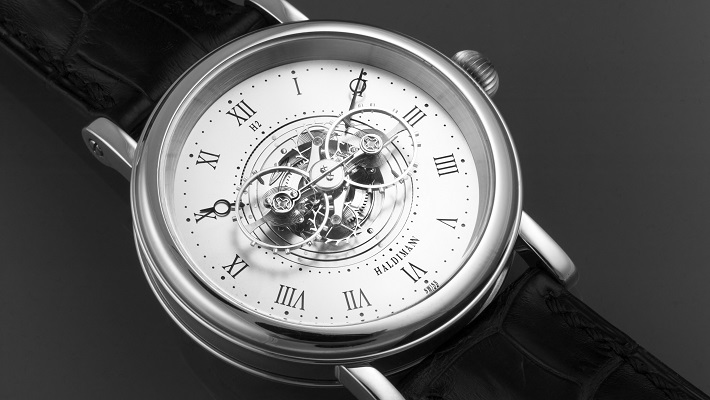
Haldimann H2 Flying Resonance, photo courtesy – Beat Haldimann, © Ralf Baumgartner
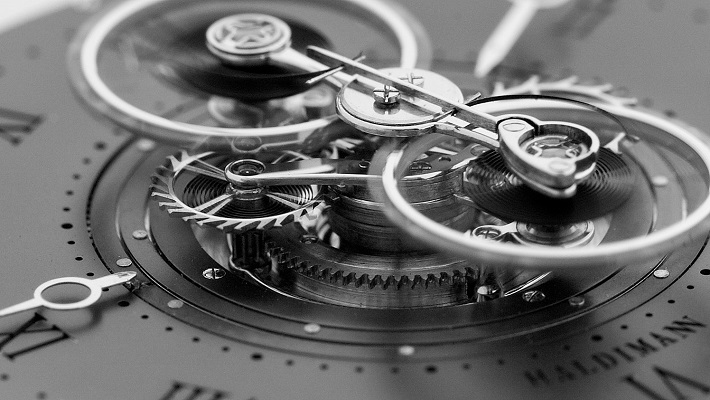
Haldimann H2 Flying Resonance, photo courtesy – Beat Haldimann, © Valentin Blank
Vianney Halter Deep Space Resonance
The most recent example of resonance in contemporary watchmaking is from master watchmaker Vianney Halter, with the prototype of his Deep Space Resonance announced on 5th January 2021.
It embodies a true labour of love, inspired by the resonant transfer of energy between piano strings when Halter started learning to play in 1996. He set about studying the works of Breguet, and other watchmakers and the resonance timepieces to learn more. It took until 2007 before he started creating his demonstrator model in his workshop to put what he had learned into practice.
Work on the project had started to take a bit of a back seat until in 2016 the scientific breakthrough in detecting gravitational waves re-inspired Halter to continue pursuing his resonance dream.
The result is utterly mind-blowing and well worth the wait: taking his 2013 Deep Space Tourbillon as a foundation, he incorporated two balance wheels into the tri-axis tourbillon (representing the three dimensions of space wrapped in the fourth dimension of time), such that the two balance wheels synchronise with one another thanks to acoustic resonance.
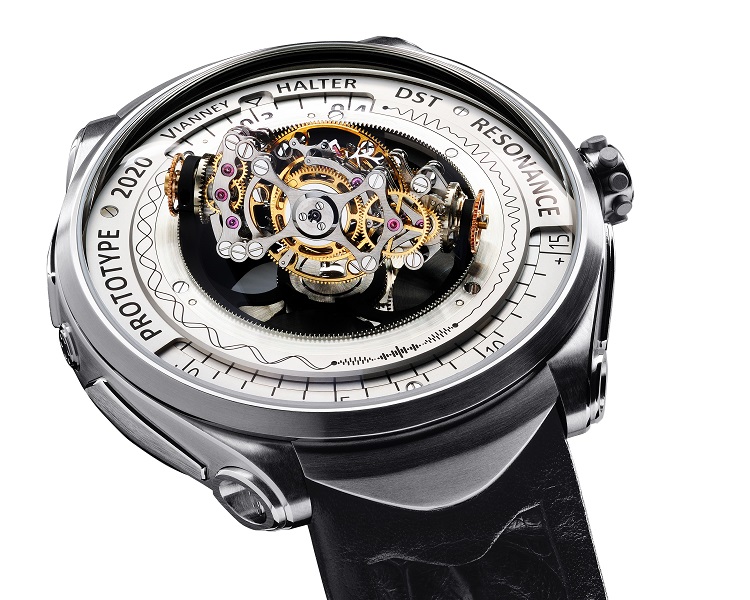
Vianney Halter Deep Space Resonance, photo courtesy – Vianney Halter, © Guy Lucas de Peslouan
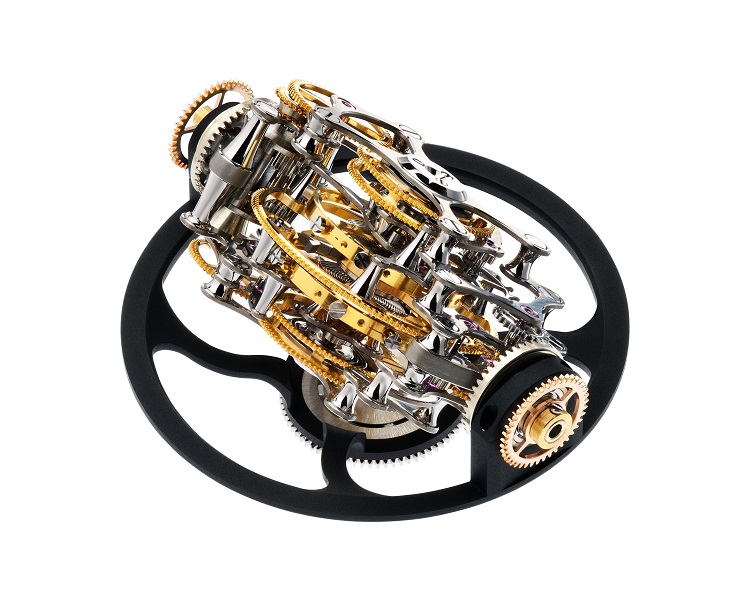
Photo courtesy – Vianney Halter, © Guy Lucas de Peslouan
The significance of acoustic resonance as opposed to mechanical resonance means that the balance wheels oscillate at the same frequency, but not necessarily in the same direction. This is what Halter calls the ‘resonance mode’ and will vary depending on the starting point of the balance wheels when the movement is wound to the point it starts to work. This mode will remain the same until the power runs out, but next time it starts up this would vary again thanks to the phenomenon of resonance.
In summary
Now, I won’t for one minute pretend that I fully understand resonance. However, what I can say is that I found it far easier to wrap my head around by watching a few videos and seeing it in action, and from that it becomes a lot clearer as to what the objectives or using resonance in watchmaking are. I have added a video at the end of this article which if you are interested in resonance in watchmaking is well worth a watch.
Resonance itself is amazing… creating something which instigates a controlled resonance is even more so. Harnessing this to realise an improvement in functionality and accuracy, and then putting this on such a scale that it can be worn on somebody’s wrist? Nothing short of genius.
As contemporary watchmaking looks to push boundaries and explore new ways of doing things, we are starting to see more examples of resonance timepieces, and personally I am excited to see where it could go. When I spoke with Claude Greisler of Armin Strom, I also took the opportunity to ask him where he thought innovations in resonance might lead in the coming years:
“The future is bright for Resonance movements. We are still at the starting point of what will be possible in the near future. You can add complications, new forms of interpretation. We believe that a Resonance timepiece should definitely be part of every watch collection with a big diversity.”
Finally, I would like to extend a huge thank you to everyone who helped make this article possible through sharing their photography and speaking with me (please click on a contributor to visit their website):
If you have any questions, please get in touch via our Contact page, or via our Instagram.
Armin Strom - Let's Talk About Resonance
You might also be interested in:
- “It’s complicated”: an introduction to the Equation of Time
- “It’s complicated”: an introduction to the Mechanical Alarm
- “It’s complicated” Part 1: an introduction to the Tourbillon
- Watch Stationery and Gift Ideas
- Watch Books, Watch Boxes and more at the Watch Affinity Shop on Amazon (commissions earned)
As an Amazon Associate, I earn from qualifying purchases – thank you for your support

